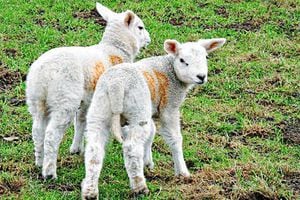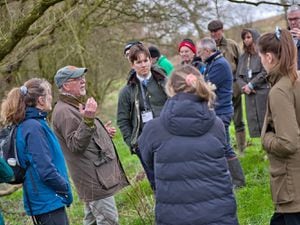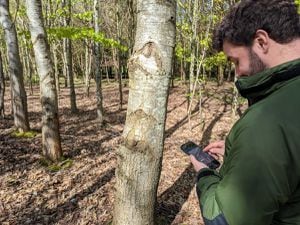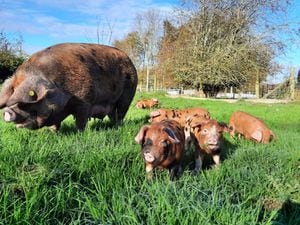Record keeping is key to success at lambing
John Parry of Donington House Farm on the Staffordshire Shropshire border at Albrighton is one of most able sheep farmers in the Midlands.
He is meticulous in his flock record keeping and is prepared to detail his failings as well as his successes making his flock a popular choice for ADAS, EBLEX and feed companies to illustrate points of husbandry to farmers.
This was the case at a meeting on the farm in December when BOCM PAULS led discussion on the nutritional aspects of John's flock, which is fed on its concentrates, whilst EBLEX looked at his likely profit margins in 2014.

Alison Ewing the sales manager of the feed company said four million lambs die in this country in the days before lambing or the first few days after lambing. This loss costs the industry £120 million, 55 per cent of which is due to poor nutrition.
John has 600 mule ewes and 50 Suffolk cross Mule ewes, all of which he puts to Signet-recorded Suffolk tups from Tom Cox at Marston near Newport. He used to buy 150 shearling North Country Mules himself from the annual sales at Skipton but now prefers to buy those shearlings each year from a Shropshire farmer friend who buys them as ewe lambs at Skipton the year before.
"I find they are more settled," said John.
All his ewes are brought inside to his big, side-wall protected Dutch barn, long before lambing, which carefully arranged, takes place over a 12 week period.
Lambing starts in early January, beginning with his Suffolk cross ewes. Ewes are age-identified by different coloured tags and penned inside in lambing groups. The oldest ewes are tupped so they lamb first. All work at lambing is carried out by John himself and the vet students he trains on the job each year.
His largest losses at lambing have been caused by toxoplasma, so he now vaccinates all replacement ewes. Overall in 2008/9 he lost eight per cent of his ewes, in 2011/12 that was down to five per cent. This year his scanning figures show a 200 per cent potential lambing, up from 186 per cent in 2008/9. The number of ewes found barren at scanning have halved, from three per cent.
Overall lamb losses (from scanning onwards) dropped from 29 per cent in 2008/9 down to 15 per cent in 2011/12, a huge reduction. These improvements, he said, are down to the culling at weaning of all ewes older than five years of age and the sale of unproductive ewes. He nowadays doses all breeding ewes and rams for fluke.
Concentrate feeding starts six weeks before lambing for ewes expecting triplets, with 0.7kg of Ewbol 18, changed to 0.8kg of the higher ME and Undegradable Protein level product Super Ewbol 19 at four weeks before lambing. The ration is increased to 1.5kg a day from two weeks before lambing. The triplets ewes are fed 0.9kg of high quality hay at six weeks, consumption of which by two weeks before lambing has dropped to 0.4kg as space in the rumen is greatly limited by the growing foetuses. Their total food intake remains at around 1.9kg of dry matter for these 70kg ewes.
Twin bearing ewes are eating 0.8kg ad lib of best hay at six weeks before lambing, reducing to 0.6kg at two weeks. They are fed 0.7kg of BOCM PAULS Super Ewbol 19 from six weeks prior to lambing, rising to 0.8kg at a month off lambing. This is increased to 1.2kg at two weeks prior to lambing. Singles are eating 1.8kg of reasonable quality hay up to a month before, but in 2012/13 by two weeks off, appetite for the hay had dropped to 1.6kg.
The BOCM PAULS 18 per cent crude protein concentrate feed Ewbol 19, aimed at indoor lambed flocks expecting 175 per cent-plus lambing percentages, incorporates added vitamin E, selenium and cobalt.The FibreZyme inclusion helps to increase fibre digestibility and lift the milk fat level.
The patented live yeast feed Levucell Titan is included to help raise rumen pH. These additions in the concentrate diet with 0.5 per cent magnesium and at two per cent a much greater calcium level than is needed by calving cows, all help lambs stand and suckle more quickly after birth, and reduce infant mortality.
"Well-fed ewes produce more colostrum and milk but correctly fed ewes produce better quality milk with a 30 per cent difference in lamb growth at weaning," said Alison Ewing. "Analysing the quality of your winter forage is essential."
Senior EBLEX advisor Clive Brown reminded his Donington Farm audience that although we are by far the biggest lamb producers in Europe, Australia and New Zealand produce many more lambs than we do. New Zealand, which has increased the average carcase size of lambs they are sending us to 18/19kg, are also sending more cut up meat, particularly legs and saddles. In total that should be no more lamb this year than last year.
A third of the lamb crop from our 14.27 million ewes, the same flock size as a year ago, is being sold abroad. France is our most important customer taking 70 per cent. The weekly prices will be spikey he says, as their prime lamb buyers at our auction marts react sharply to changes in the value of the Euro. If the value of the pound against the Euro drops they can pay more, and will buy more.
The second most important market is Hong Kong and it is growing, as is the substantial market for sheep offals in Ghana.





